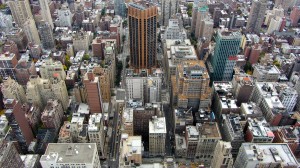2015 WL 1524672
New York Court of Appeals
Decided on April 7, 2015
Blog by: Stephen N. Preziosi Esq., Criminal Appeals Lawyer
The New York Court of Appeals puts another nail in the coffin of the Fourth Amendment: Police Officers’ Mistaken Understanding Of The Law Justifies The Stop.
Issue: Whether there is probable cause to make a traffic stop for a suspected violation of law in accordance with article I, 12 of the New York State Constitution and the Fourth Amendment of the United States Constitution if the justification for the stop is based upon a police officers objectively reasonable, but mistaken, understanding of the law?
Summary: Defendant was arrested in the Village of Newark, Wayne County and charged with failing to stop at a stop sign in violation of Vehicle and Traffic Law 1172(a) and driving while intoxicated under Vehicle and Traffic Law 1192(2) and (3). She moved to suppress the evidence obtained during the stop asserting that the arresting officer lacked probable cause for the initial stop. The Newark Village Court took judicial notice that the stop sign was located in a parking lot and not registered in the Village Code Newark Village Code 140?46). The court granted the motion and dismissed the charges on the ground that the stop was not justified because the stop sign was not properly registered as required by Vehicle and Traffic Law 1100(b). The Wayne County Court affirmed concluding that the offices good-faith belief that defendant ran a legally authorized stop sign was insufficient to blink away any irregularities in the laws he [was] attempting to enforce. The Court of Appeals granted leave to appeal and reversed.
Holding: The Court of Appeals held that evidence recovered as a result of a traffic stop need not be suppressed where a police officer had an objectively reasonable, but mistaken, belief that he or she has witnessed a violation of the Vehicle and Traffic law.
 Facts: Defendant was stopped by a police officer at approximately 12:15 a.m. on September 27, 2009 after he observed her vehicle drive past a stop sign without stopping. The stop sign was located at the edge of a supermarket parking lot in the Village of Newark, Wayne County. At the time of the stop, defendant was exiting the parking lot onto a public street. Upon stopping defendant, the officer smelled a strong odor of alcohol. Defendant failed field sobriety tests, and a breath analysis revealed that her blood alcohol level was over the legal limit. Therefore, the officer arrested defendant and charged her with failing to stop at a stop sign in violation of Vehicle and Traffic Law 1172(a) and driving while intoxicated under Vehicle and Traffic Law 1192(2) and (3). The Newark Village Court granted defendants motion to suppress the evidence and dismissed the charges. The Wayne County Court affirmed. The Court of Appeals granted leave to appeal and reversed.
Facts: Defendant was stopped by a police officer at approximately 12:15 a.m. on September 27, 2009 after he observed her vehicle drive past a stop sign without stopping. The stop sign was located at the edge of a supermarket parking lot in the Village of Newark, Wayne County. At the time of the stop, defendant was exiting the parking lot onto a public street. Upon stopping defendant, the officer smelled a strong odor of alcohol. Defendant failed field sobriety tests, and a breath analysis revealed that her blood alcohol level was over the legal limit. Therefore, the officer arrested defendant and charged her with failing to stop at a stop sign in violation of Vehicle and Traffic Law 1172(a) and driving while intoxicated under Vehicle and Traffic Law 1192(2) and (3). The Newark Village Court granted defendants motion to suppress the evidence and dismissed the charges. The Wayne County Court affirmed. The Court of Appeals granted leave to appeal and reversed.
Legal Analysis: In reaching its decision, the Court of Appeals started by reciting the police power/Fourth Amendment balancing test outlined by the Supreme Court of the United States: any exercise of police power under the Fourth Amendment of the United States Constitution must be reasonable ? a seizure by the police may not be arbitrary (Heien v. North Carolina, 135 S.Ct. 530, 536[2014]). Under New York law, a traffic stop is a seizure and is permissible under the Fourth Amendment and the New York State Constitution when a police officer has probable cause to believe that the driver of an automobile has committed a traffic violation (People v. Robinson, 97 N.Y.2d 341, 349[2001]). Probable cause does not require proof sufficient to warrant a conviction beyond a reasonable doubt but merely information sufficient to support a reasonable belief that an offense has been or is being committed or that evidence of a crime may be found in a certain place ?(People v. Bigelow, 66 N.Y.2d 417, 423[1985]). Under these standards, a police officer need only articulate credible facts establishing a reasonable cause to believe that someone has violated a law to establish a reasonable basis to effectuate a stop and seizure (Robinson, 97 N.Y.2d at 353-354).
 Turning to the facts of the case, it was undisputed that the stop sign at issue was not legally valid because it was not properly registered as required by?Vehicle and Traffic Law 1100(b). However, the court determined that the question presented was not whether the police officer acted in good-faith, but whether his belief that a traffic violation had occurred was objectively reasonable under the circumstances (People v. Estrella, 10 N.Y.3d 945, 946[2008]). Applying the standards articulated in Heien and Estrella, the divided bench concluded that the traffic stop was justified under both the Fourth Amendment and the New York State Constitution based upon the officers reasonable belief that defendant failed to stop at a valid stop sign. The stop sign in question was of regulation color, height, and dimension. And although it was not properly registered, it is presumed to be official by being placed in a position approximately conforming to the requirements of Vehicle and Traffic Law 1110(c). The police officer was neither charged with knowing that the stop sign at issue was not registered, nor required to verify that it was valid before making the traffic stop. Rather, the traffic stop was based upon probable cause because the police officer reasonably believed under the circumstances that he had observed defendant violate the Vehicle and Traffic Law. Finally, public policy does not prohibit investigatory stops based upon mistakes of law. Accordingly, the order of County Court was reversed, defendants motion to suppress denied, and the case remitted to the Village Court for further proceedings.
Turning to the facts of the case, it was undisputed that the stop sign at issue was not legally valid because it was not properly registered as required by?Vehicle and Traffic Law 1100(b). However, the court determined that the question presented was not whether the police officer acted in good-faith, but whether his belief that a traffic violation had occurred was objectively reasonable under the circumstances (People v. Estrella, 10 N.Y.3d 945, 946[2008]). Applying the standards articulated in Heien and Estrella, the divided bench concluded that the traffic stop was justified under both the Fourth Amendment and the New York State Constitution based upon the officers reasonable belief that defendant failed to stop at a valid stop sign. The stop sign in question was of regulation color, height, and dimension. And although it was not properly registered, it is presumed to be official by being placed in a position approximately conforming to the requirements of Vehicle and Traffic Law 1110(c). The police officer was neither charged with knowing that the stop sign at issue was not registered, nor required to verify that it was valid before making the traffic stop. Rather, the traffic stop was based upon probable cause because the police officer reasonably believed under the circumstances that he had observed defendant violate the Vehicle and Traffic Law. Finally, public policy does not prohibit investigatory stops based upon mistakes of law. Accordingly, the order of County Court was reversed, defendants motion to suppress denied, and the case remitted to the Village Court for further proceedings.

